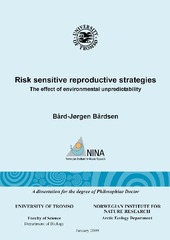Risk sensitive reproductive strategies : the effect of environmental unpredictability
Permanent lenke
https://hdl.handle.net/10037/2807Åpne
Thesis introduction (PDF)
Bårdsen, B.-J., T. Tveraa, P. Fauchald, and K. Langeland: «Observational evidence of a risk sensitive reproductive allocation in a long-lived mammal», manuscript, reprinted with permission. Published version: Oecologia (2010) 162:627-639 (doi: 10.1007/s00442-009-1537-0). (PDF)
Bårdsen, B.-J., J.-A. Henden, P. Fauchald, T. Tveraa, and A. Stien: «Plastic reproductive allocation as a buffer against environmental stochasticity – linking life history and population dynamics to climate», manuscript, reprinted with permission. Published version: Oikos (2011) Volume 120, Issue 2, pages 245–257 (doi: 10.1111/j.1600-0706.2010.18597.x) (PDF)
Dato
2009-02-13Type
Doctoral thesisDoktorgradsavhandling
Forfatter
Bårdsen, Bård-JørgenSammendrag
A crucial task in ecology is to quantify trade offs between competing
demographic processes for experienced by individuals that inhabit
unpredictable environments. Perhaps the most widely studied trade off is
that between current reproduction and future survival (‘the cost of
reproduction’). While experimental studies have been widely used to
quantify life history strategies in birds, virtually no experimental
studies have been carried out on large and free ranging mammals. This
thesis quantifies how female reindeer Rangifer tarandus subject to
variability in food availability, trade their resources between
reproduction and body mass to ensure own survival. By combining two
experiments, one observational study and one theoretical model, this
thesis show that: (1) Individuals subject to reduced food availability
in one winter feeding promptly reduced their reproductive allocation the
following summer to increased their autumn body mass. On the other hand,
short-term improved conditions did not result in increased reproductive
allocation. (2) Long-term improved winter feeding conditions did,
however, result in increased reproductive allocation. (3) Reproduction
was costly, especially for smaller females, as occasional harsh winters
and high population density resulted in reduced reproduction and lowered
female body mass. Moreover, a successfully reproducing female produced a
smaller offspring in the coming year relative to a barren one. Reindeer
also differ in their intrinsic quality as successfully reproducing
females’ showed an increased probability of reproducing also in the
following year. (4) In harsh and unpredictable winter conditions, the
optimal reproductive strategy involved a low reproductive allocation per
unit female spring body mass. Under such conditions females increased
their autumn body mass to enhance their own survival. Conversely, the
optimal reproductive strategy in benign and predictable conditions
involved a higher reproductive allocation. (5) Reproductive strategies
and environmental conditions had significant effects on population
dynamics. Female reindeer do not to jeopardize their own survival and
adjust their reproductive allocation in order to buffer periods of low
food availability in a risk sensitive manner. Klima og klimaendringer påvirker reproduksjon og overlevelse hos alle
levende organismer. Denne avhandlingen inkluderer flere eksperimenter
der vinterbetingelsene ble forbedret eller forverret ved å manipulere
fôrtilgangen til reinsimler. En reduksjon i vinterbetingelsene førte til
at simlene neste sommer reduserte investeringen i kalv, og isteden
satset på oppbygging av kroppsreserver. En tilsvarende forbedring av
vinterbetingelsene måtte imidlertid foregå over flere år før simlene var
villige til å øke sin reproduktive investering. Et observasjonsstudie
viste at vinterforholdene ikke bare påvirker investeringen i kalv, men
også kostnadene knyttet til dette. De asymmetriske konsekvensene av
forbedring og forverring koblet til et uforutsigbart vintermiljø viser
at reinsdyr har utviklet en risikosensitiv investeringsstrategi der
simlene avpasser bygging av fettreserver basert på hva slags vinter de
forventer skal komme. I et modellarbeide blir det vist at denne typen
strategi vil være optimal, og videre hvordan slike strategier vil
påvirke bestandene under ulike klimascenerier. Økt nedbør og mildere
vintre i Finnmark vil i tråd med disse studiene på sikt gi betydelig
lavere reintall og større dyr med lav villighet til å investere i
kalveproduksjon
Beskrivelse
Papers number 1 and 2 of the thesis are not available in Munin, due to publishers' restrictions:
1. Bårdsen, B.-J., P. Fauchald, T. Tveraa, K. Langeland, N. G. Yoccoz, and R. A. Ims: "Experimental evidence for a risk sensitive reproductive allocation in a long-lived mammal", Ecology (2008)89:829-837 (Ecological Society of America). Available at http://dx.doi.org/10.1890/07-0414.1
2. Bårdsen, B.-J., P. Fauchald, T. Tveraa, K. Langeland, and M. Nieminen: "Experimental evidence of cost of lactation in a low risk environment for a long-lived mammal", Oikos (2009)118:837-852. Available at http://dx.doi.org/10.1111/j.1600-0706.2008.17414.x
1. Bårdsen, B.-J., P. Fauchald, T. Tveraa, K. Langeland, N. G. Yoccoz, and R. A. Ims: "Experimental evidence for a risk sensitive reproductive allocation in a long-lived mammal", Ecology (2008)89:829-837 (Ecological Society of America). Available at http://dx.doi.org/10.1890/07-0414.1
2. Bårdsen, B.-J., P. Fauchald, T. Tveraa, K. Langeland, and M. Nieminen: "Experimental evidence of cost of lactation in a low risk environment for a long-lived mammal", Oikos (2009)118:837-852. Available at http://dx.doi.org/10.1111/j.1600-0706.2008.17414.x
Forlag
Universitetet i TromsøUniversity of Tromsø
Metadata
Vis full innførselSamlinger
Copyright 2009 The Author(s)
Følgende lisensfil er knyttet til denne innførselen:


 English
English norsk
norsk
